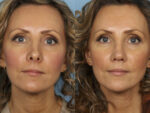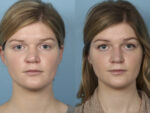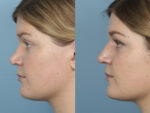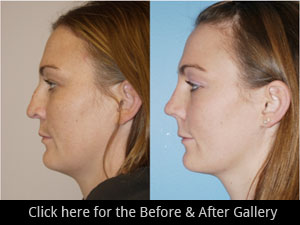Dr. Sidle is one of the leading septorhinoplasty surgeons at Northwestern Memorial Hospital in Chicago. Because of his double board certification by both the American Board of Facial Plastic and Reconstructive Surgery and the American Board of Otolaryngology-Head and Neck Surgery, he is often consulted by other surgeons in cases of unsatisfactory rhinoplasty outcomes.
These are especially difficult cases as both appearance and breathing of the nose can be affected. Dr. Sidle has accepted cases from all over the country and has even performed revisions rhinoplasty on patients whose original surgery was performed outside the U.S.
What is The Most Common Thing Patients Say About Their Prior Surgeon?
Dr. Sidle most commonly hears the following: “I thought the doctor understood what I wanted. But he did something entirely different from what I asked! It was as if we never had a conversation!”
When you see Dr. Sidle as a patient, he listens to your concerns, what you want to be fixed and what you don’t want to be fixed. Then, he may undertake computer-imaging with you, so that you and he can agree on a shared surgical goal. Along with his office notes, Dr. Sidle refers to these pictures throughout the surgery.
How much does it cost to get the revision rhinoplasty?
The average cost of revision rhinoplasty surgery is $6,000. However, the price can vary depending on the surgeon’s experience and location.
Some factors that may affect the cost of revision rhinoplasty surgery include:
- The complexity of the procedure
- The type of anesthesia used
- The geographic location
- Additional procedures that may be performed simultaneously as revision rhinoplasty surgery.
What Are Dr. Sidle’s Qualifications?
Dr. Sidle is board certified in both Otolaryngology-Head and Neck Surgery and Facial Plastic and Reconstructive Surgery. He did his surgical residency training in Otolaryngology-Head and Neck Surgery at Northwestern University Medical School in Chicago. Dr. Sidle completed his specialty training with a fellowship in Facial Plastic Reconstructive Surgery at the University of California, San Francisco. In 2005, Dr. Sidle was appointed as Director of the Division of Facial Plastic and Reconstructive Surgery in the Department of Otolaryngology – Head and Neck Surgery at Northwestern University.
Why Dr. Sidle is preferred Surgeon for Revisions Rhinoplasty in Chicago Region?
Undergoing revision rhinoplasty is a difficult decision. Dr. Sidle understands that you are already disappointed, and you are likely afraid of further surgery. Selecting a surgeon who specializes in rhinoplasty and, in particular, revision surgery is your best next step in the healing process.
Experience Matters. As a board certified Facial Plastic Surgeon at Northwestern with expertise in the face and neck, Dr. Sidle can provide you with an individualized plan to achieve your goals of a more youthful face. Call our office for a one-on-one consultation.
Revisions Rhinoplasty FAQs
Revision rhinoplasty is not generally more painful than primary rhinoplasty. Several factors can influence the amount of pain a person experiences after surgery, including the severity of the original problem, the skill of the surgeon, and the type of anesthesia used. Most people find that revision rhinoplasty surgery is significantly less painful than their initial surgery. This is because surgeons have had more experience with revision surgeries and can be more precise in their work. In addition, modern techniques and anesthetics ensure that patients experience minimal pain during and after surgery.
A good candidate for revision rhinoplasty is someone who is unhappy with the appearance of their nose after previous surgery and does not have any medical issues that could interfere with the surgery or healing process.
It depends on the person’s healing process, but generally, it takes anywhere from four to six weeks for the wounds to heal completely. Most people feel better after two or three weeks, but giving your body enough time to recover fully before resuming your normal activities is important.
Yes, revision rhinoplasty can change your smile. Most often, when people have revision rhinoplasty surgery to improve the appearance of their nose, they also request a dental consultation to discuss any changes that can be made to their smile. In some cases, minor alterations to the position of the teeth can make a big difference in improving the smile’s overall appearance.
Yes, revision rhinoplasty can be worth it if the first surgery was unsuccessful or if there are other issues with the nose that need to be corrected. Revision surgery can address problems such as a crooked nose, a nasal bone that is too long or too short, or damage caused by an injury.
There is usually a waiting period between the first and second rhinoplasty surgeries. This is because the first surgery is used to assess the patient’s anatomy and determine what needs to be done in the second surgery. The second surgery is then used to correct any problems identified in the first surgery. Usually, you have to wait for the 2nd revision rhinoplasty for about a year. However, it varies depending on the individual case. You should consult your surgeon to get a better idea of how long you’ll need to wait.
It depends on the insurance policy. Generally, most insurance companies will cover revision surgery if it is deemed medically necessary. However, each policy is different, and there may be specific exclusions or limitations in coverage. It is important to review your individual policy carefully to determine if revision surgery is covered.
After revision rhinoplasty surgery, you should take a few precautions. First, keep your head elevated as much as possible in the days following surgery. This will help reduce swelling and minimize the chance of developing blood clots. You will also need to avoid strenuous activity or heavy lifting for at least two weeks after surgery. Drink plenty of fluids and eat a healthy diet to speed up healing. These simple steps can ensure a smooth and successful recovery from revision rhinoplasty surgery.
There are several options for revision rhinoplasty, including open or closed revisions, shortening or lengthening the nose, eliminating dorsal humps, and correcting asymmetries. The surgeon will select the best approach based on the individual patient’s needs and goals.
Post-Operative Instructions
All post-operative instructions can be found on the Patient Resources page.
Our Results
Click Here to access our Before and After gallery for all procedures.






